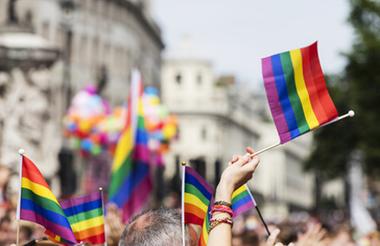Three of the largest 250 charities in the country currently report the difference in average pay between their heterosexual and LGBTQIA+ staff, according to research by Civil Society.
Analysis of the top 250 charities by income, according to Charity Finance’s 100 and 250 Indexes, shows that NSPCC, Unicef UK and Sustrans were the only charities to record their sexual orientation pay gap in 2022.
Meanwhile, Barnardo’s stated in its diversity pay gap report that it intends to publish its LGBTQIA+ pay gap next year.
The type of data collected varied between charities.
Unicef’s and Sustrans’ pay gaps measured the difference in average pay between cisgender heterosexual staff and their LGBTQIA+ colleagues.
Meanwhile, NSPCC measured the difference in remuneration between its heterosexual and LGBQ staff, focusing on sexual orientation rather than gender identity.
Kevin Taylor-McKnight from campaign group Charity So Straight praised the charities that were monitoring pay LGBTQIA+ pay disparities and said it was a positive step towards creating a diverse workforce.
Cisgender heterosexual staff paid more at Unicef
Unlike the gender pay gap, which organisations with more than 250 employees must report on, there is no legislation ensuring sexual orientation pay gaps are reported.
In its first year of publishing data, Unicef reported a pay gap of 7.2%, meaning LGBTQIA+ staff earn 93p for every £1 their heterosexual colleagues make on average.
The charity said in its report that it aims to increase the amount of data it collects to provide further analysis.
“We are working to increase disclosure levels for sexual orientation and disability,” the report reads.
“We are aware however that actions put in place to reduce gaps for other protected groups almost certainly will have an impact on reducing the following gaps too.”
Jon Sparkes, executive director for Unicef UK said: “We voluntarily collected and published our ethnicity, disability and sexual orientation pay gap because we want to focus attention on diversity and inclusion at the Unicef UK; to show our commitment to act and to ensure that we are tackling issues openly and meaningfully.
“Whilst we have made progress employing staff from minoritised ethnic communities, now representing just under half of all new recruits to our workforce, we do not yet have as many senior leaders from minoritised ethnic communities, with a disability or LGBTQIA+ as we would like.
“We are continuing our work in this area by improving our recruitment process to reduce bias, upskilling our colleagues, rolling out a new inclusive talent programme and ensuring we have active staff networks that support our work on diversity and inclusion and help to shape decisions.”
Sustrans pay gap shrinks
Sustrans, which began reporting its LGBTQIA+ pay gap data in 2020, saw its sexual orientation pay gap shrink from 2.4% in 2021 to 0% last year.
Its report reads: “LGBTQ+ colleagues earn on average 27p per hour more than heterosexual colleagues.
“This is an improvement from 2021 when our sexual orientation pay gap was 4.2% and LGBTQ+ colleagues earned on average 62p per hour less than heterosexual colleagues.”
Tiffany Lam, Sustrans strategy lead for equality, diversity and inclusion, said: “Sustrans is committed to creating an equitable, diverse and inclusive working environment for everyone.
“As part of this commitment, we report our pay gap for different diversity dimensions, in addition to gender, to increase transparency and engage more meaningfully with our workforce, ensuring we become a more diverse and inclusive place to work and volunteer.”
Pay advantage at NSPCC
NSPCC, which has published the data since 2021, reported its sexual orientation pay gap as -2.2% last year, compared to -3.8% in 2021, with the negative figures indicating a pay advantage for LGBQ staff.
It also reported that the proportion of heterosexual staff that received a bonus payment was 1.3% in 2022 compared to 0.9% of their LGBQ colleagues.
Cristina Bertua Mera, head of reward and benefits at the NSPCC, said: “At the NSPCC, we believe being open and transparent about our pay gaps is an essential step to help us achieve and embed a diverse and inclusive culture.
“This is why in 2021 we decided to voluntarily publish our first diversity pay gap report. This includes mandatory male and female gender pay gap reporting as well as reporting that extends to the protected characteristics of ethnicity, disability, and sexual orientation.
“When reporting on the sexual orientation pay gap the comparison is made between those who are heterosexual and those who are lesbian, gay, bisexual or another sexual orientation.
“We are pleased the pay gap has become more equal overall as we are committed to valuing everyone equally and fairly for the contribution they make.”
Charity So Straight: ‘In collecting this data, charities send a clear message’
Kevin Taylor-McKnight from campaign group Charity So Straight said: “It’s not a surprise to hear that the LGBTQIA+ pay gap isn’t really a consideration for most charities, but it really ought to be so we have an intersectional approach to understanding and tackling pay inequality.
“Without question, failure to report on pay disparity for any protected characteristic can contribute to salary inequity.
“Having said that, before we get into discussing the pay gap for LGBTQIA+ employees, charities need to go back to basics, and ensure they are creating a workplace culture where people feel they can bring their authentic selves to the workplace, because until we do that, any pay gap data is likely to be incomplete.”
Taylor-McKnight said it was “great” to see a small number of charities already reporting on this pay gap.
“In starting to collect data around LGBTQIA+ pay inequality, charities send a very clear message to employees (and prospective employees) that they care about intersectional diversity, and that’s an important message to send if you really want to create a diverse workforce,” he said.












